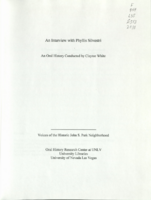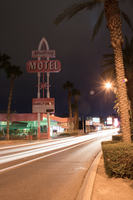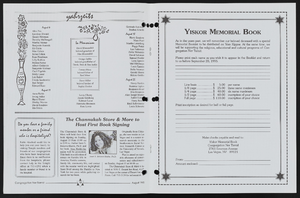Search the Special Collections and Archives Portal
Search Results

Transcript of interview with Joel Bergman by Stefani Evans and Claytee D. White, August 03, 2016
Date
Archival Collection
Description
Born in 1936, architect Joel Bergman spent his childhood in Venice, California, the son of Edythe Klein and Harry Bergman, a baker who later turned to dealing in scrap metal. The award-winning designer of such Las Vegas projects as the International Hotel, the MGM Grand Hotel (later Bally's), additions to the Riviera Hotel and the Golden Nugget downtown, the Mirage, Treasure Island, Paris Casino Resort, Caesars Palace, Trump International Hotel and Tower, the Signature at MGM Grand, Rhumbar, Gilley's at Treasure Island, and the Tropicana Hotel and Casino first arrived in Las Vegas in 1968 to work on the International Hotel. In this interview, Bergman discusses his architectural career, which began with his graduation in architecture from the University of Southern California; he also discusses his work with Martin Stern, his sixteen years with Steve Wynn, and the formation of his own architectural firm, Bergman Walls and Associates. Throughout, he pays tribute to the three mentors who had the greatest influence on his work—USC architecture professor Carleton Winslow, architect Berton Severson, and client Steve Wynn—and the ways they visualized people moving through space. He acknowledges other professionals whose work he admired and talks about his wives Marlene Federman, Terrie Colston, Maria Nicolini, and Valentina Bogdanova as well as his children and stepchildren. Joel David Bergman passed away August 24, 2016, three weeks after he gave this interview.
Text

Transcript of interview with J.W. Campbell by Raymond Haft, February 19, 1979
Date
Description
On February 19, 1979, Raymond Haft interviewed his friend, J. W. Campbell (born June 13, 1918 in Pioche, Nevada). This interview covers the history of Nevada, including Mr. Campbell’s personal history and the growth of Nevada, overall. Mr. Campbell discusses the Stewart Ranch, the Mormon Fort, swimming pools in Las Vegas, and the above ground atomic tests. He also recalls the crash of Carole Lombard’s plane and the building of the Basic Magnesium Plant in Henderson. Mr. Campbell calls Las Vegas a “One industry town,” stating that gambling (and tourism) are the main and major factors in Las Vegas, Nevada.
Text

Richard W. Bunker Interview, July 18, 2017, July 21, 2017, and September 28. 2017: transcript
Date
Archival Collection
Description
Fourth-generation Nevadan, Las Vegas native, and great grandson of Mormon pioneer Edward Bunker, Richard W. Bunker knows Southern Nevada as few others do. For example, when Richard Bunker speaks of water, he talks about his father's family leaving their home after the completion of Hoover Dam because their little town of St. Thomas was submerged in the rising waters of Lake Mead; he recalls swimming at the Old Ranch pool, the Springs, and the Mermaid pool; he shares stories of hiring Pat Mulroy, mentoring her, and encouraging her to apply to lead the Las Vegas Valley Water District; he mentions the Dunes and its two fresh-water wells, the Sanitation District and wastewater treatment. Few others have actively shaped Southern Nevada as Richard Bunker has through his lengthy career as a lobbyist (1973–2000); assistant manager for City of Las Vegas (1973–77); Clark County Manager (1977–79); member and Chair of the Nevada Gaming Control Board (1980–1982); executive director (1988-1990) and
Text

Transcript of interview with Gerald Gordon by Barbara Tabach, November 02, 2016
Date
Archival Collection
Description
In 1961, at the age of thirteen, Gerald ?Jerry? Gordon became a bar mitzvah. This typical coming of age celebration was unusual in that he had simultaneously studied in both his home state of California and his adopted home of Las Vegas, where he spent summers with his grandparents. 1961 is also the same year that the Gordons made Las Vegas their permanent home. Jerry graduated from Las Vegas High School, attended University of Nevada, Las Vegas and earned his law degree from University of California, Los Angeles. His gregarious and trustworthy personality led him to career building steps in the legal community of Las Vegas that included illustrious names such as Louis Wiener, Jr., David Goldwater, Neil Galatz, and many others. His personal law specialty became bankruptcy, especially dealings with hotel/casinos. As a member of the Jewish community, Jerry?s energy and expertise to organize was instrumental in the construction of Congregation Ner Tamid, the reform synagogue, at its site on Valle Verde and I-215. It was a multi-year process and includes a vast array of stories?a cash donation from Moe Dalitz, finalization of receiving of a donation land from the Greenspun family during the High Holy Days, and the ongoing challenges of a building campaign during a recession. In addition, he explains that CNT included two unique negotiations: 1) a cell tower and 2) a solar field on the synagogue?s property. Jerry and his wife Yvonne met while attending UNLV. Yvonne taught math at various levels in the Clark County School District. They raised their two children, Sara and Jeffrey, in Las Vegas, and forged an important role together in Congregation Ner Tamid. In April 2017, they were among those honored for their work with the synagogue.
Text

Transcript of interview with Phyllis Silvestri by Claytee White, January 11, 2010
Date
Archival Collection
Description
As a young woman, Phyllis Silvestri made the adventurous decision to move to the United States. She was bom in Canada and lived there until her early 20s. Over the next few years, Phyllis and her friend Mona logged many miles, worked and visited several states. By 1953, Phyllis had met and married Vincent Silvestri, who worked at Bingo Palace, now the Sahara Hotel and Casino. Soon they had their first child and had bought a home on Santa Rosa. A few years later they were building a new home in the John S. Park area. She proudly recalls her husband's attention to details such as including lots of built-in features and a bomb shelter that represents the era. Phyllis talks fondly of the neighborhood, but also recalls her children not being allowed to play with some of the neighborhood children because they were of Italian ancestry.
Text

Interview with Linda (Mack) Smith, June 30, 2004
Date
Archival Collection
Description
Text

Photographs of Monterey Motel sign, Las Vegas (Nev.), February 12, 2017
Date
Archival Collection
Description
Site address: 1133 S Las Vegas Blvd
Sign owner: Monterey Motel Corp.
Sign details: The building was constructed in 1944 (Assessor). The business opened as the Monterey Lodge Motel (RoadsideArchitecture). A vintage postcard from 1954 shows The Monterrey Lodge Motel with much of the current architecture, although a different sign is present (Las Vegas motels then and now). The motel advertises itself as endorsed by several automobile clubs, including the Automobile Association of America (AAA).
Sign condition: Condition is 4, good. The cabinets, light boxes and neon are intact and in good condition. The paint shows slight fading and no flaking or peeling, except for light to moderate deterioration and rust on the bottom of the lower cabinet.
Sign form: Double pole sign
Sign-specific description: Double poles painted in bands of pink topped by bands of white support a rectangular reader board with a pink metal cabinet. Plastic pink sans serif letters spell out "FAMILY UNITS" on the face of the readerboard. On the lower motel side of the readerboard is a rectangular black plastic sign which states, "COLOR TV by RCA" in multi-colored san serif letters. At the top of the cabinet on the motel side is an arrow pointing toward the business. At the top of the north face of the cabinet is white coated skeleton neon tubing which states, "ENTER NO VACANCY" in sans serif letters. On the south face of the cabinet the lettering is reversed to say, "NO VACANCY ENTER". Mounted above the readerboard are three poles. The two outside poles are painted white and consist of round pedestals, shafts and capitals. The capitals are outlined in white skeleton neon. The rectangular interior pole is painted pink. A pink, rectangular bar (from an asterisk now covered by plastic wrap advertising) intersects the middle of all three poles. A rectangular shield shaped metal cabinet painted pink sits on the poles above the readerboard. White sans serif letters outlined in black paint and clear skeleton neon spell out "MOTEL". The three poles continue out of the cabinet to support a second pink metal readerboard which features "Monterey" spelled in plastic cursive letters. The three poles extend above the second reader board where they join to make an arch. The two outside poles are outlined in white skeleton neon.
Sign - type of display: Neon and Reader boards
Sign - media: Steel and Plastic
Sign - non-neon treatments: Reader boards
Sign environment: This is located on Las Vegas Boulevard South just north of the strip.
Sign - date of installation: Circa 1950's-1960's (RoadsideArchitecture)
Sign - date of redesign/move: A 2009 photograph shows the sign painted blue (Virus, 2009). Flaking paint under the "COLOR TV by RCA" sign shows an older layer of blue paint. A sign of similar age in the parking lot of the motel is still painted the same light blue shown in the photograph.
Sign - thematic influences: There is a Googie star on the sign as well as an arch which was a popular 1950's/60's sign design. Also they advertise automobile clubs on their sign and have a western ranch style building which are also Mid-Century Modern trends as well.
Sign - artistic significance: The sign showcases Googie, Western and motor court artistic aspects.
Survey - research locations: Clark County Assessor, Parcel No. 162-03-112-034. Retrieved from http://www.clarkcountynv.gov/assessor/Pages/PropertyRecords.aspx?H=redrock&P=assrrealprop/pcl.aspx Las Vegas motels then and now. (n.d.) Monterey Lodge - 1133 South Las Vegas Blvd. Retrieved from http://stefanidrivesvegas.com/8.html RoadsideArchitecture. (n.d.). Monterey Motel. Retrieved from http://www.roadarch.com/signs/nvvegas3.html Virus, R. (2009 April 5). Monterey Motel, Las Vegas, NV. Retrieved from https://www.flickr.com/photos/25229906@N00/5769946413/in/photostream/
Surveyor: Mitchell Cohen
Survey - date completed: 2017-09-04
Sign keywords: Steel; Plastic; Reader board; Neon; Pole sign; Back to back; Backlit
Mixed Content
Rabbi Yocheved Mintz Photographs
Identifier
Abstract
The collection is comprised primarily of photographs of Rabbi Yocheved Mintz at different events and programs held at Las Vegas, Nevada synagogue Congregation P'nai Tikvah from 2006 to 2017. The collection includes photographs of congregants during different workshops and events held at the synagogue. The collection also includes photographs of Rabbi Mintz and congregants during holidays (Hannukah, Purim, Rosh Hashanah, and Passover), Jewlicious (Jewish education classes and workshops), and from the congregation newsletter.
Archival Collection
Clark County Department of Air Quality and Environmental Management Records
Identifier
Abstract
The Clark County Department of Air Quality and Environmental Management Records (1988-2006) contain materials related to Southern Nevada resource management, air quality, and community planning, particularly related to population growth in Clark County, Nevada. Materials include federal regulations and acts, reports, and land sales, as well as local agency reports, memorandums, workshop pamphlets, maps, and plans.
Archival Collection

